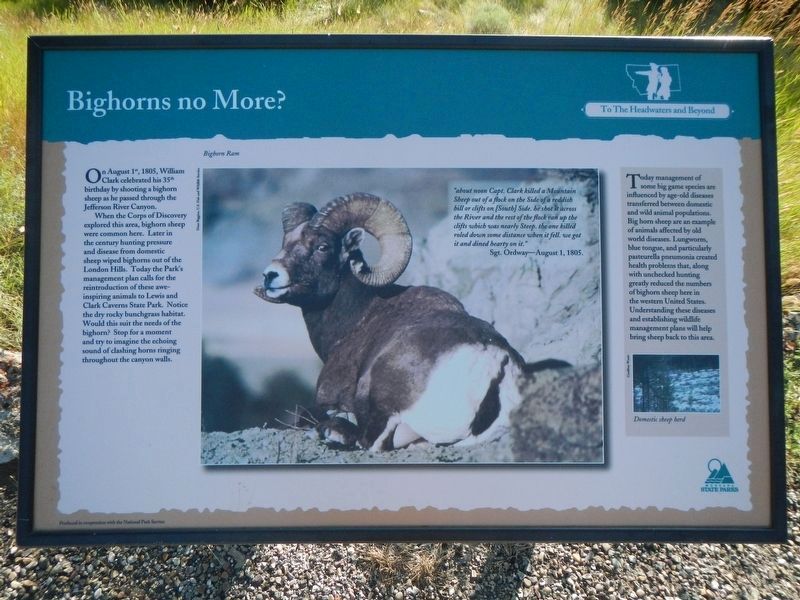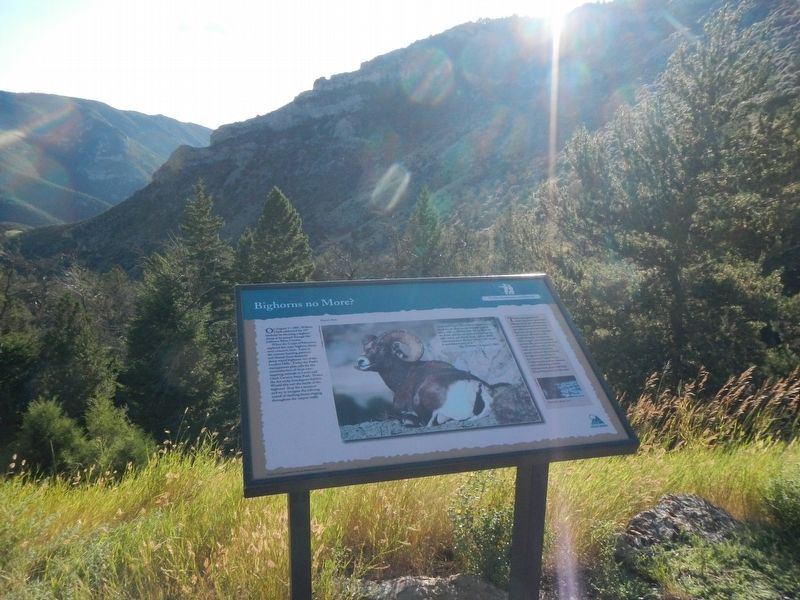Near Cardwell in Jefferson County, Montana — The American West (Mountains)
Bighorns no More?
Inscription.
On August 1st, 1805, William Clark celebrated his 35th birthday by shooting a bighorn sheep as he passed through the Jefferson River Canyon.
When the Corps of Discovery explored this area, bighorn sheep were common here. Later in the century hunting pressure and disease from domestic sheep wiped bighorns out of the London Hills. Today the Park's management plan calls for the reintroduction of these awe-inspiring animals to Lewis and Clark Caverns State Park. Notice the dry rocky bunchgrass habitat. Would this suit the needs of the bighorn? Stop for a moment and try to imagine the echoing sound of clashing horns ringing throughout the canyon walls.
"about noon Capt. Clark killed a Mountain Sheep out of a flock on the Side of a reddish hill or cliffs on (South) Side. he shot it across the river and the rest of the flock ran up the cliffs which was nearly Steep. the one killed rolled down some distance when it fell. we got it and dined hearty on it." Sgt. Ordway - August 1, 1805
Today management of some big game species are influenced by age-old diseases transferred between domestic and wild animal populations. Big horn sheep are an example of animals affected by old world diseases. Lungworm, blue tongue, and particularly pasteurella pneumonia created heart problems that, along with unchecked hunting greatly reduced the numbers of bighorn sheep here in the western United States. Understanding these diseases and establishing wildlife management plans will help bring sheep back to this area.
Erected by Montana State Parks.
Topics and series. This historical marker is listed in these topic lists: Animals • Exploration. In addition, it is included in the Lewis & Clark Expedition series list. A significant historical date for this entry is August 1, 1805.
Location. 45° 50.301′ N, 111° 52.042′ W. Marker is near Cardwell, Montana, in Jefferson County. Marker is on State Highway 2. Touch for map. Marker is at or near this postal address: 1455 Montana Highway 2, Cardwell MT 59721, United States of America. Touch for directions.
Other nearby markers. At least 5 other markers are within 10 miles of this marker, measured as the crow flies. Lean Times Ahead (a few steps from this marker); Lewis and Clark Caverns Entrance Building (approx. 1.3 miles away); LaHood Park (approx. 2.8 miles away); Lewis & Clark Expedition (approx. 2.8 miles away); Welcome to Parker Homestead State Park (approx. 9.2 miles away).
More about this marker. This marker is located in Lewis and Clark Caverns State Park near the entrance to the caverns.
Credits. This page was last revised on October 26, 2019. It was originally submitted on October 26, 2019, by Barry Swackhamer of Brentwood, California. This page has been viewed 179 times since then and 10 times this year. Photos: 1, 2. submitted on October 26, 2019, by Barry Swackhamer of Brentwood, California.

